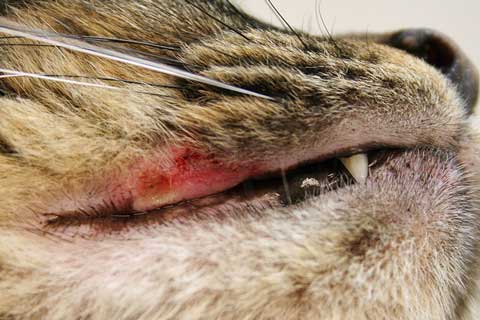The name “rodent ulcer” is very misleading. It is a lump or granuloma which has nothing to do with rodents. Apparently, these lumps were given the name because they looked like a tiny rodent bite on the skin. The better name is: eosinophilic ulcer. So, what causes this lump?
They occur near the canine teeth on the upper lip. The lump is caused by inflammation because of a congregation of white blood cells which were mobilised by the cat’s immune system to react to the presence of something foreign to the cat.

White blood cells are sent to areas where they are required to kill a pathogen in the cat’s body which is their job. White blood cells are attracted to pathogens and they surround them and bind to them and engulf them. The enzymes inside the cell breakdown the pathogen to destroy it.
When white blood cells are mobilising this way, they normally disperse after they have done their job but sometimes they remain in the area for a long time causing an inflammation in the area and a lump as described.
To the human eye they look sensitive but I’m told by Dr. Bruce Fogle DVM that they are not usually painful or itchy. Although they start off as a lump, they can become ulcerated because cats sometimes lick them a lot. I guess they feel the lump and, as in humans, they lick it because its presence is irritating.

As the cat’s tongue is rough in containing backward facing spines, it causes more damage than the granuloma itself.
Rodent ulcers are part of three inflammatory skin conditions called eosinophilic ulcer, eosinophilic plaque and eosinophilic granuloma. They are grouped together as “eosinophilic granuloma complex”. What’s the cause? Environmental allergies, food allergies and fleas play a role in creating these skin conditions. Anecdotally, it is said that plastic bowls may cause rodent ulcers perhaps because of bacteria which can grow inside crevices in the damaged plastic. Plastic bowls are not recommended as you probably know because it is also said that they can cause feline acne the same reason. Ceramic and metal are better.
Apparently, the treatment is steroids which help to speed up natural healing and antibiotics can take care of a secondary bacterial infection. A vet might recommend that it is left alone to heal naturally.
White blood cells are also known as ‘eosinophils’. A ‘pathogen’ is a microorganism such as a virus or bacterium which causes disease.
Below are some more articles on itchy skin.

